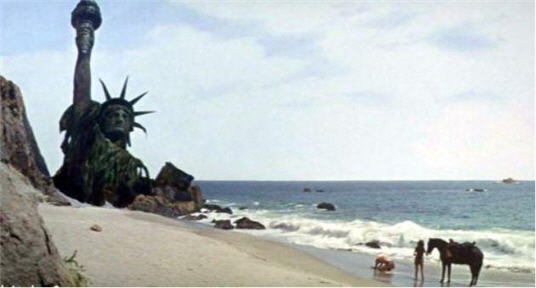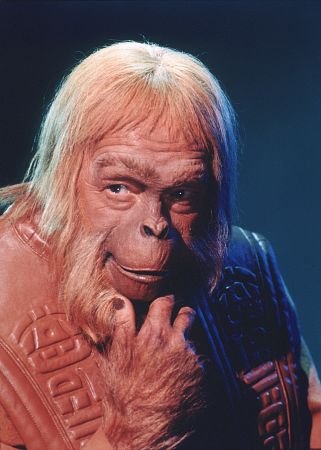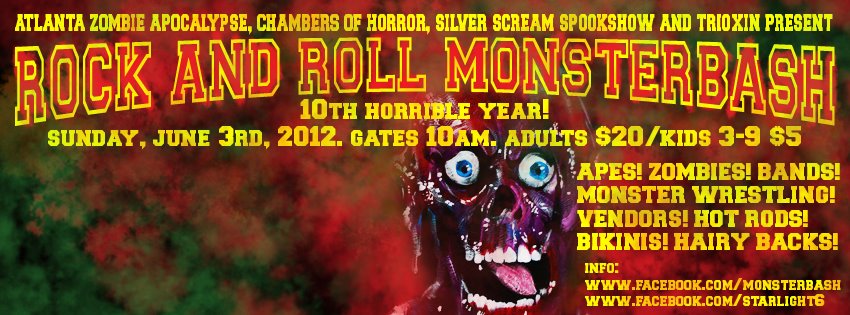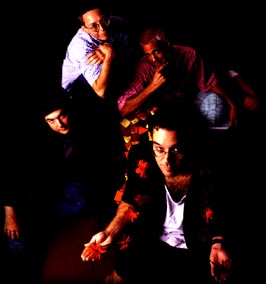 by Gene Kannenberg, Jr.
by Gene Kannenberg, Jr.
Guest Contributing Writer
PLANET OF THE APES (1968); Dir: Franklin J. Schaffner; Writer: Michael Wilson and Rod Serling; Starring Charlton Heston, Roddy McDowall, Kim Hunter, Maurice Evans; 10th annual Rock N Roll Monster Bash 2012, Starlight Drive-In, Sun. June 3; gates at 10 a.m. and movies at dusk; trailer here; an all-day, all-night horror festival featuring Monstrosity Championship Wrestling hosted by the Silver Scream Spookshow‘s Professor Morte. Bands include X-Impossibles, Bigfoot, Dead Elvisand more. Also playing: RETURN OF THE LIVING DEAD (1985)
I can barely remember a time when I did not know about PLANET OF THE APES (1968).
Watching the PLANET OF THE APES movies was a ritual for me when I was a boy in the early-to-mid 1970s. WVTV Channel 18, Milwaukee’s independent TV station, used to run POTA marathons at least once a year, it seemed; every Friday for five weeks in a row we’d get another installment, and I was always riveted to the screen, beginning, of course, with the original film directed by Franklin Schaffner and originally released in 1968.
After all, the idea of astronauts from Earth discovering a world ruled by talking animals is tailor-made for a child who has outgrown (for the time being) fairy tales but is fascinated by (1) the space program (we were still going the moon back then) and (2) dinosaurs and other monsters. The action was intense, the apes looked wonderful (some noble, others menacing), and the ideas were mind-expanding, thanks in no small part to script work by Rod Serling of THE TWILIGHT ZONE fame.
Was there ever a more effective introduction of menace into a film than the attack by the gorillas in the cornfield? The mute fear of the humans; the shots of the whips above the corn; Jerry Goldsmith’s harsh, urgent soundtrack; and the ultimate reveal of the gorillas on horseback, with the zoom-in on a gorilla’s face? It was breathtaking at the time, and it’s still a powerful moment today.
I wish I could tell you how shocked and stunned I was the first time that I, along with Taylor (Charlton Heston), discovered the half-buried Statue of Liberty and realized that the Planet of the Apes was, in fictional-fact, our own planet Earth. I wish I could, but I can’t; because I can’t remember ever not knowing this fact. I’m sure I was awestruck the first time around—how could a child not have been, after witnessing such a brutal, unfamiliar world? All I can remember is enjoying the ride each and every time I watched the movie—any of the movies, even the less-than-stellar BATTLE FOR THE PLANET OF THE APES (1973). (And that Statue of Liberty moment has, rightly, become one of the most famous in movie history – in fact, it was even included in a film better-known as being an adaptation of HAMLET )
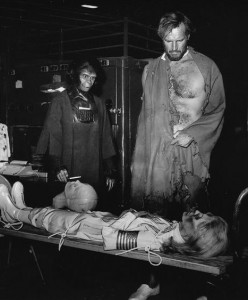
Taylor (Charlton Heston), Zira (Kim Hunter) and the body of dead astronaut Stewart (Diane Stanley). PLANET OF THE APES (20th Century Fox, 1968)
I must admit that, to my young mind, one of the most mysterious and terrifying parts of the the movie came early on with the death of Stewart (an uncredited Diane Stanley), the female astronaut who doesn’t survive suspended animation. When Taylor discovers her corpse, it all happens so fast that I was never sure what was going on. In hindsight, it’s clear that her cryogenic capsule failed, and that her body mummified during the other astronauts’ long sleep. But when I was a child, I couldn’t understand why she looked the way she did. We only see her corpse for a second, so that added to the mystery. For the longest time, I thought that perhaps she had somehow been turned into an ape as some sort of warning. Now, I realize that doesn’t make any sense; but when you’re eight years old, sense is a precious, elusive quantity. Seeing her corpse as a warning of what was to come made perfect, terrible sense to me back then.
Watching these movies on TV also gave me my first taste of behind-the-scenes promotional films. Sometimes Channel 18 would pad out the movies to three hours, but even with commercials there would still be time left over before the 10 o’clock news. So they occasionally filled the extra minutes with “making-of” documentaries about either the POTA films or the short-lived live-action PLANET OF THE APES television series (1974). Here was my first glimpse into “movie magic,” and in particular, the fascinating world of prosthetic makeups. Nerdy kid that I was, I found myself amazed at the skill and ingenuity that makeup creator John Chambers and his crew demonstrated in slowly, slowly building up appliances onto the actors’ faces, transforming them into incredibly believable simians.
I was so taken with the makeup process that I decided to try it myself. However, being eight years old (or so) and without access to latex and yak fur, I made do with what I had available: paper, crayons, scissors, and tape. Building upon what I’d seen in the documentaries, I made articulate ape masks for my younger brother John and myself. (I got to be a chimpanzee, natch; my brother became an orangutan. And when a cousin would visit, he or she’d have to settle with being a gorilla.)
First I’d create a somewhat triangular piece that surrounded the eyes and came down to create a nose. That was the easy part. The hard part was the mouth. I wanted it to look like the muzzles the apes had in the movies: That meant a mouth in two pieces, top and bottom, each a sort of quarter-sphere. I’d color a piece of paper “ape flesh” color (depending upon the type of ape) and then cut notches along the edges so that I could mold it into the proper hollow shape, securing the seams with tape, until they were (approximately) the right shape.
Finally came the miles of tape needed to attach the paper appliances to our faces. The only way to allow the mouths to open and close as we spoke was to affix the two pieces separately to our skin. This took a lot of tape (and made the eventual removal of the masks a little uncomfortable – but hey, this was art). Once the mouths were in place, then came the eye/nose pieces, with the descending noses laid atop the upper mouthpiece. (I remember that one time when I was feeling particularly ambitious, I added a third piece to the mouths: A piece of paper crayoned as black as I could make it, to cover our real mouths behind the muzzles; this way, when we spoke, you couldn’t see our real mouths inside the masks.)
The hair was trickier, but I had a solution. We had winter hats that covered our whole heads, with just a hole cut out in the front for our faces. Perfect! The fact that my hat was blue and my brother’s was green kind of spoiled the verisimilitude, but hey, that’s what imagination was for. The final touch was a triangular piece of paper on each side of our faces to approximate the facial cheek-hair that crept under the eyes and wrapped around the muzzles.
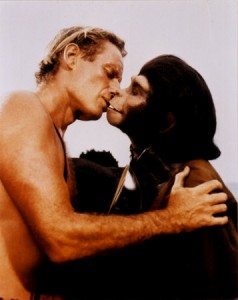
Taylor (Charlton Heston) and Zira (Kim Hunter) exchange a kiss in PLANET OF THE APES (20th Century Fox,1968).
Lord, how I wish I had photos of us in these masks. I’m sure they looked mostly ridiculous, but we loved them, and we would jump around the house, howling like apes.
But anyway, the Apes movies made a huge impression on me as a child. They instilled in me a love of science fiction, a love of movies, and a healthy dose of cynicism with regards to official structures of power. They were all “of their time,” that time being the late 1960s/early 1970s, and issues of discrimination were inescapable cultural touchstones, even for a young child. And the Apes films were, in their way, statements against discrimination and pleas for tolerance and understanding. (For more on this topic, see Eric Greene’s book PLANET OF THE APES AS AMERICAN MYTH: RACE, POLITICS, AND POPULAR CULTURE.)
Of course, the apes movies are also a whole lot of fun. Some of it might seem a bit campy nowadays, and of course, some of the lines have become cultural touchstones in their own right (“Get your stinking paws off me, you damned, dirty ape!”). But the films, the first in particular, still represent some of the best movie-making magic there ever was. I envy you Atlantans the chance to experience it on the big drive-in screen. Now, watch like Apes!

